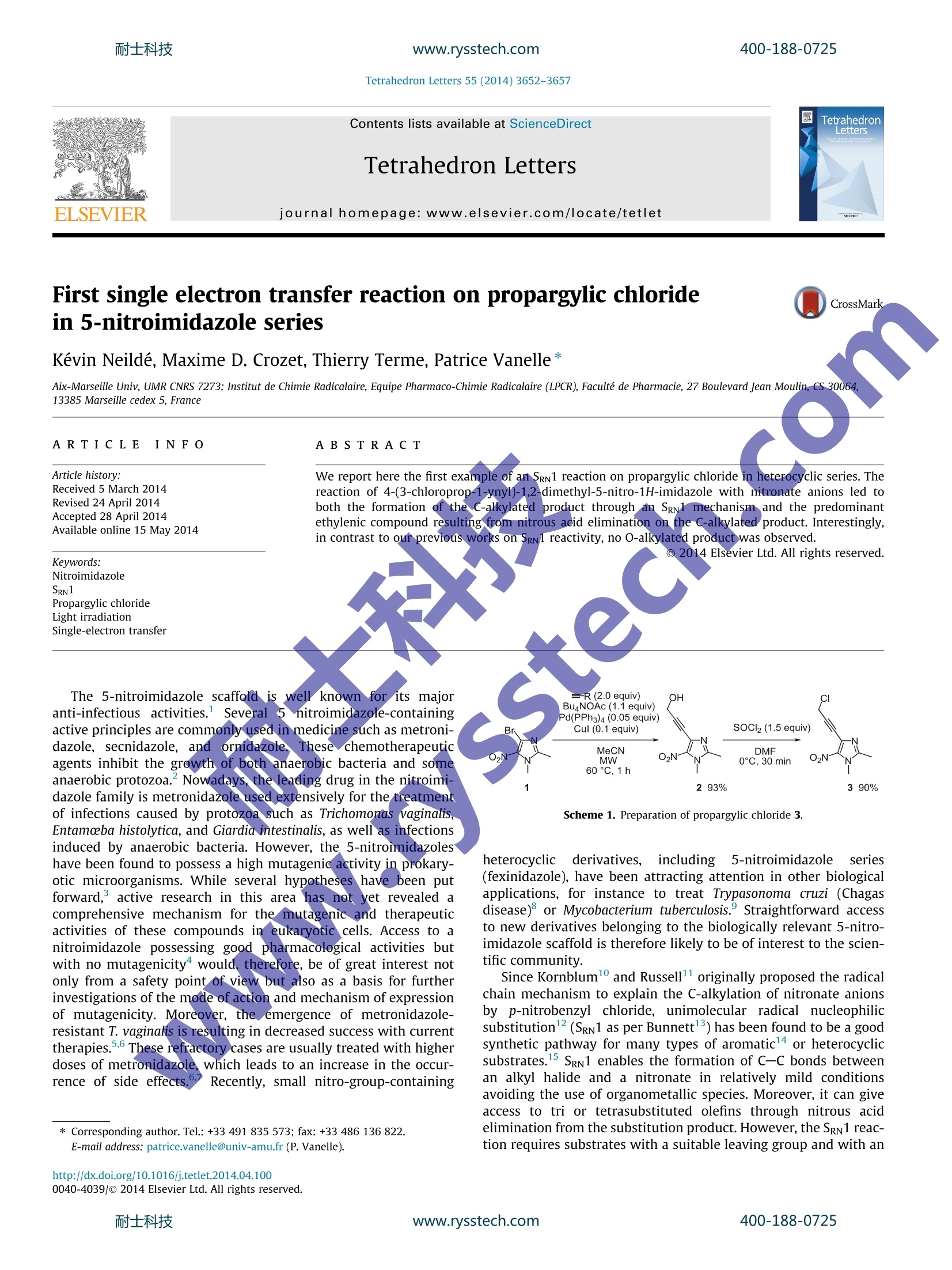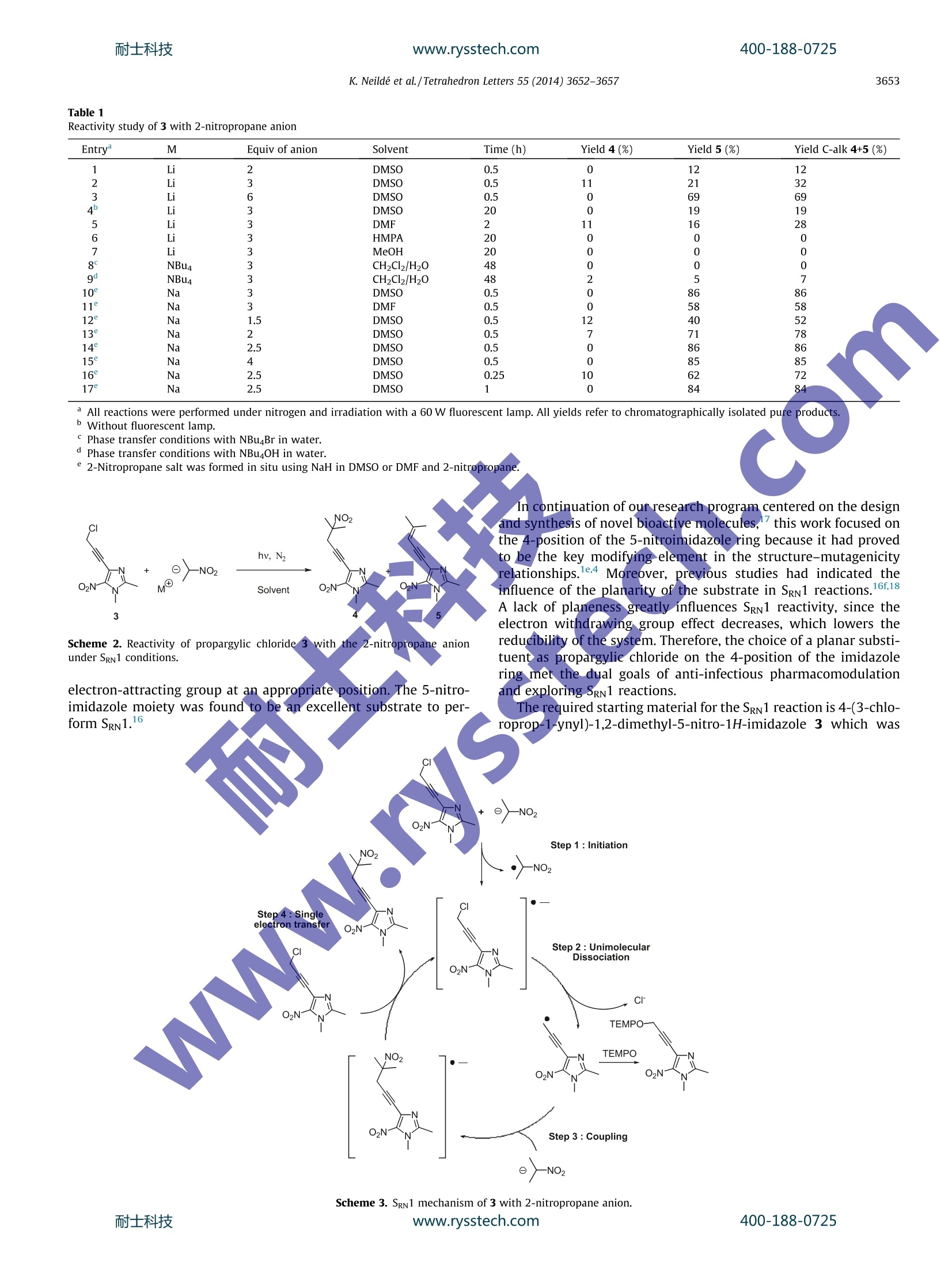
方案详情
文
We report here the first example of an SRN1 reaction on propargylic chloride in heterocyclic series. The reaction of 4-(3-chloroprop-1-ynyl)-1,2-dimethyl-5-nitro-1H-imidazole with nitronate anions led to both the formation of the C-alkylated product through an SRN1 mechanism and the predominant ethylenic compound resulting from nitrous acid elimination on the C-alkylated product. Interestingly, in contrast to our previous works on SRN1 reactivity, no O-alkylated product was observed.
方案详情

耐士科技400-188-0725www.rysstech.comTetrahedron Letters 55 (2014)3652-3657 400-188-0725耐士科技www.rysstech.com3653 Contents lists available at ScienceDirect Tetrahedron Letters ELSEVI ER journal homepage: www.elsevier.com/locate/tetlet First single electron transfer reaction on propargylic chloridein 5-nitroimidazole series CrossMark Kevin Neilde, Maxime D. Crozet, Thierry Terme, Patrice Vanelle* Aix-Marseille Univ, UMR CNRS 7273: Institut de Chimie Radicalaire, Equipe Pharmaco-Chimie Radicalaire (LPCR), Faculte de Pharmacie, 27 Boulevard Jean Moulin, CS 30064,13385 Marseille cedex 5, France ARTICLEINF0 ABSTRACT Article history:Received 5 March 2014Revised 24 April 2014Accepted 28 April 2014Available online 15 May 2014 We report here the first example of an SRN1 reaction on propargylic chloride in heterocyclic series. Thereaction of 4-(3-chloroprop-1-ynyl)-1,2-dimethyl-5-nitro-1H-imidazole with nitronate anions led toboth the formationofthe C-alkylatedproduct through an SRy1 mechanism and the predominantethylenic compound resulting from nitrous acid elimination on the C-alkylated product. Interestingly,in contrast to our previous works on SRN 1 reactivity, no O-alkylated product was observed. The 5-nitroimidazole scaffold is well known for its majoranti-infectious activities.Several1 5 nitroimidazole-containingactive principles are commonly used in medicine such as metroni-dazole, secnidazole, andornidazole.These chemotherapeuticagents inhibit the growth of both anaerobic bacteria and someanaerobic protozoa.Nowadays, the leading drug in the nitroimi-dazole family is metronidazole used extensively for the treatmentof infections caused by protozoa such as Trichomonas vaginalis,Entamoeba histolytica, and Giardia intestinalis, as well as infectionsinduced by anaerobic bacteria. However, the 5-nitroimidazoleshave been found to possess a high mutagenic activity in prokary-otic microorganisms. While several hypotheses have been putforward, active research in this area has not yet revealed acomprehensive mechanism for the mutagenic and therapeuticactivities of these compounds in eukaryotic cells. Access to anitroimidazole possessing good pharmacological activities butwith no mutagenicity would, therefore, be of great interest notonly from a safety point of view but also as a basis for furtherinvestigations of the mode of action and mechanism of expressionof mutagenicity. Moreover, the emergence of metronidazole-resistant T. vaginalis is resulting in decreased success with currenttherapies.5.6 These refractory cases are usually treated with higherdoses of metronidazole, which leads to an increase in the occur-rence of side effects.,Recently, small nitro-group-containing * Corresponding author. Tel.: +33 491 835 573; fax: +33 486 136822. ( E-mail address: p atrice.vanel l e@univ-a m u.f r (P. Va n elle). ) Scheme 1. Preparation of propargylic chloride 3. heterocyclicdderivatives.including 5-nitroimidazoleSseries(fexinidazole), have been attracting attention in other biologicalapplications, for instance to treat Trypasonoma cruzi (Chagasdisease)or Mycobacterium tuberculosis.°Straightforward accessto new derivatives belonging to the biologically relevant 5-nitro-imidazole scaffold is therefore likely to be of interest to the scien-tific community. Since Kornblumand Russell originally proposed the radicalchain mechanism to explain the C-alkylation of nitronate anionsby p-nitrobenzyl chloride, unimolecular radical nucleophilicsubstitution(SRN1 as per Bunnett) has been found to be a goodsynthetic pathway for many types of aromaticl4 or heterocyclicsubstrates.Sen1 enables the formation of C-C bonds betweenan alkyl halide and a nitronate in relatively mild conditionsavoiding the use of organometallic species. Moreover, it can giveaccess to tri or tetrasubstituted olefins through nitrous acidelimination from the substitution product. However, the SRn1 reac-tion requires substrates with a suitable leaving group and with an K. Neilde et al./Tetrahedron Letters 55 (2014) 3652-3657 Table 1Reactivity study of 3 with 2-nitropropane anion Entry° M Equiv of anion Solvent Time (h) Yield 4 (%) Yield 5 (%) Yield C-alk 4+5 (%) 2 DMSO : 0 3 DMSO 11 6 DMSO 0.5 4 3 DMSO 5 DMF 11 3 HMPA 0 0 0 3 MeOH 0 NBu4 3 CH2Cl2/H20 0 0 0 NBu4 3 CH2Cl2/H20 2 5 10 3 DMSO 0 3 DMF DMSO 0.5 13° DMSO 14 DMSO 15 DMSO DMSO 0.25 DMSO a All reactions were performed under nitrogen and irradiation with a 60 W fluorescent lamp. All yields refer to chromatographically isolated pure products.Without fluorescent lamp. e 2-Nitropropane salt was formed in situ using NaH in DMSO or DMF and 2-nitropropane. Scheme 2. Reactivity of propargylic chloride 3 with the 2-nitropropane anionunder SRN1 conditions. electron-attracting group at an appropriate position. The 5-nitro-imidazole moiety was found to be an excellent substrate to per-form SRN1. Scheme 3. SRN1 mechanism of 3 with 2-nitropropane anion.www.rysstech.com prepared in two sequential steps from 4-bromo-1,2-dimethyl-5-nitro-1H-imidazole 1 (Scheme 1).19 The only example of SeN1reaction performed on a triple bond was described by Rochel4fon 1-(3-chloroprop-1-ynyl)-4-nitrobenzene. However, the electrontransfer is closely connected to the intramolecular electrondelocalization toward the nitro group which is very substratedependent. Thus, an entire SRN1 reactivity study of 4-(3-chloro-prop-1-ynyl)-1,2-dimethyl-5-nitro-1H-imidazole 3 was needed. First, optimization reactions were performed (Table 1) to iden-tify the best SRN1 conditions between 3 and the commerciallyavailable 2-nitropropane. The SRN1 reaction led to the twoexpected products, C-alkylated product 4 and ethylenic compound5 resulting from nitrous acid elimination on C-alkylated product 4(Scheme 2). The by-product generally observed during studies ofSRN1 reactivity is a product with aldehyde function resulting froman O-alkylation according to an Sw2 mechanism. 0-12 Surprisingly,this by-product was never observediina our conditions hasmonitored by LC/MS. Moreover, contrary to our previous study14f Table 2Inhibition of reaction between 3 and 2 nitropropane anion Entry scavenger 4+5(%) 1 None 86 2 TEMPO 0.1 equiv 13 3 TEMPO 1 equiv 4 02 (bubbling) 0 5 p-DNB 1 equiv on 1-(3-chloroprop-1-ynyl)-4-nitrobenzene, no trace of the nitro-but-1-enyl derivatives was observed. Under Kornblum conditions 14a-c (Table 1, entries 1-5), 6 equivof 2-nitropropane lithium salt were required to obtain C-alkylatedproducts 4+5 in good yields (Table 1, entries 1-3).Moreover, theC-alkylated products were formed slowly and poorly in theabsence of luminous irradiation (Table 1, entry 4). DMSO provedto be the best solvent to perform the C-alkylation reaction (Table 1,entries 2, 5-7, 11). Trials with DMF led to poorer yields for thesame reaction time (Table 1, entries 10 and 11) while methanoland HMPA did not yield any C-alkylated products 4+5. DMSOshould promote solvation of counteranions in 2-nitropropaneanion sodium or lithium salt better than DMF, inducing higher basestrength in 2-nitropropane anion. Norris transfer phase condi-tions14d mainly led to starting chloride 3 with degradation prod-ucts and with no or poor yield of C-alkylated compounds 4+5(Table 1, entries 8 and 9). Contrary to benzylic series, the choiceof the counter cation of the nitropropane salt proved to be animportant parameter (Table 1, entries 2 and 10). The best resultswere defined by in situ generation of the 2-nitropropane anionusing NaH (Table 1, entries 10-17). Subsequently, reaction time,solvent, and number of equivalents of the 2-nitropropane anionwere tested (Table 1, entries 10-17) to identify optimal conditions.Thus, the best C-alkylation 4+5 yield was obtained using 2.5 equivof the 2-nitropropane anion in DMSO after 30 min under light irra-diation (Table 1, entry 14). Scheme 4. Reaction of 3 with various nitroalkane anions. Reagents and conditions: (a) general conditions: notri alkane (2.5 equiv), NaH (2.5 equiv), DMSO, rt, hv, 30 min; (b)under Norris phase transfer conditions. times and/or fewer equivalents of the 2-nitropropane anion(Table 1, entries 12, 13, and 16) which decreased the overall yieldof C-alkylated products. In order to confirm the single electron transfer mechanism(Scheme 3), inhibition reactions were performed (Table 2) byadding to the optimal reaction conditions (Table 1, entry 14)amounts of 2,2,6,6-tetramethyl-1-piperidinyloxy (TEMPO), O2, orpara-dinitrobenzene (p-DNB), commonly used as inhibitors in themechanistic study of SRN1 reactions.24Indeed, these species arewell known to act as a radical trap (TEMPO andO2) or as electronacceptor(p-DNB) disrupting the SRN1 cyclic mechanism (Scheme 3)by coupling with the propargyl radical (TEMPO and O2) or by com-peting with 3 in the electron transfer from the nucleophile duringthe initiation step (p-DNB). Inhibition for the synthesis of C-alkyl-ation products (4+5) was observed with TEMPO (Table 2, entries 2and 3), 02 (Table 2, entry 4), and p-DNB (Table 2, entry 5). Theeffects of these inhibitors on the reaction between 3 and the2-nitropropane anion provide good evidence of the SRN1 mecha-nism in the C-alkylation. 225 Following optimization, the best conditions developed duringthe study with the 2-nitropropane anion (Table 1, entry 14) wereapplied to six other nitronate anions (cycloalkane, aromatic,heterocyclic nitronates, and nitroester) (Scheme 4). The originalC-alkylated products resulting from SRN1 reaction were fully characterized.26 The corresponding nitroalkanes were either commer-cially available (formation of SRN1 product 6-8) or synthesized inone step by oxidation of amine using MCPBA15d (formation ofSRn1 product 9-11) or by nitration of N-methypyrrolidone15d (for-mation of SRN1 product 12). As observed with the 2-nitropropaneanion, these conditions led almost exclusively to ethylenic prod-ucts 6-8 and 10-12, in 24% to 84% yield of the isolated product.Compound 12 with the N-methypyrrolidone substituent, whichhas been shown to enhance antiparasitic activity in 5-nitroimidaz-ole series,2 reacted poorly with the optimizedconditionsdescribed above (Table 1, entry 14). However, Norris phase transferconditions were the best experimental conditions (45%yield)when the 1-methyl-3-nitropyrrolidin-2-one anion was used tosynthesize compound 12. This result could be explained by thepoor solubility of the N-methypyrrolidone anion in DMSO. The structure of compound 5 was unambiguously confirmed byX-ray structure analysis (Fig. Concerning the stereochemistryof the alkenes 8, 10, 11, and 12 resulting from nitrous acid elimina-tion on the C-alkylation product, E-stereoisomer was the only iso-mer observed as confirmed by X-ray analysis of crystal of 10(Fig.2).2 The other structures were assigned by analogy and spectral comparison. In conclusion, we report here the first example of SRN1 on prop-argylic chloride in heterocyclic chemistry. After optimizationbetween 4-(3-chloroprop-1-ynyl)-1,2-dimethyl-5-nitro-1H-imid-azole 3 and the 2-nitropropane anion, SRN1products 4+5 were Figure 1. Ortep plot of 1,2-dimethyl-4-(4-methylpent-3-en-1-ynyl)-5-nitro-1H-imidazole 5. Figure 2. Ortep plot of (E)-1,2-dimethyl-5-nitro-4-(4-phenylpent-3-en-1-ynyl)-1H-imidazole 10. obtained in 86% yield. The methodology was extended to othernitronate anions,notably to substituents possessing features ofbiologicaliinterest.Furthermore.4-(3-chloroprop-1-ynyl)-1,2-dimethyl-5-nitro-1H-imidazole is shown to constitute an out-standing substrate for SRn1 reactivity because of the absence ofany O-alkylated compound. This substrate could be a good startingmaterial for further single electron transfer studies. Acknowledgment This work is supported by the CNRS and the Aix-MarseilleUniversity. The authors thank the Spectropole team for elementalanalysis, HRMS spectra recording, and for X-ray analysis. Weexpress our thanks to V. Remusat for lH and 13c NMR spectrarecording. K. Neilde is grateful to the French ministry of highereducation and research for a doctoral fellowship. References and notes (a) Jorgensen, M. A.; Manos, J; Mendz, G. L.; Hazell, S. L. J. Antimicrob.Chemother.1998, 41, 67;(b)Upcroft, J. A.; Campbell,R. W.; Benakli, K.; Upcroft,Vanelle, P. Antimicrob. Agents Chemother. 1999, 43, 73; (c) Citron, D. M.;Tyrrell, K. L.; Warren, Y. A.; Fernandez, H.; Merriam, C. V.; Goldstein, E. J. C.Anderobe 2005, 11,315; (d) Leitsch, D.; Kolarich, D.; Wilson, I. B. H.; Altmann,F.;Duchene, M. PLoS Biol. 2007, 5, e211;(e)Crozet, M. D.; Botta, C.; Gasquet,M.;Curti, c.; Remusat, V.; Hutter, S.; Chapelle, O.; Azas,N.; De Meo, M.; Vanelle, P.Eur. J. Med. Chem. 2009,44, 653; (f) Kim, P.; Kang, S.; Boshoff, H. I.; Jiricek, J.;Collins, M.; Singh, R.; Manjunatha, U. H.; Niyomrattanakit, P.; Zhang, L.;Goodwin, M.; Dick, T.; Keller, T. H.; Dowd, C. S.; Barry, C. E., 3rd j. Med. Chem.2009, 52,1329;(g) Dunn, L. A.; Burgess, A. G.; Krauer, K. G.; Eckmann, L.;Vanelle, P.; Crozet, M.D.; Gillin, F.D.; Upcroft, P.;Upcroft, J. A. Int. J. Antimicrob.Agents 2010, 36,37. 2.Celik,A.; Ares Ates, N. Drug Chem. Toxicol. 2006, 29,85. 3. M1ital, A. Sci. Pharm. 2009,77,497. 4.Walsh,j. S.; Wang, R.; Bagan, E.; Wang, C. C.; Wislocki, P.; Miwa, G. T. J. Med.Chem. 1987,30, 150. 5.Cudmore,S. L.; Delgaty, S. F.; Hayward-McClelland,S. F.; Petrin, D. P.; Garber,G. E. Clin. Microbiol. Rev. 2004, 17, 783. 6.Schwebke, J. R.; Burgess, D. Clin. Microbiol. Rev. 2004, 17, 794. 7.Crowell, A. L.; Sanders-Lewis, K. A.; Secor, W. E. Antimicrob. Agents Chemother.2003,47,1407. 8.Bahia, M. T.; de Andrade, I. M.; Martins, T. A. F.; do Nascimento,A. F. D. S.; Diniz,L. D. F.; Caldas, I. S.; Talvani, A.; Trunz, B. B.; Torreele, E.; Ribeiro, I. PLoS Negl.Trop. Dis. 2012,6,e1870. 9.Carroll, M. W.; Jeon,D.; Mountz,J. M.; Lee,J. D.;Jeong, Y.J.; Zia, N.; Lee,M.; Lee,J; Via, L. E.; Lee, S.; Eum, S.-Y.; Lee, S.J.;Goldfeder, L. C.; Cai,Y.; Jin, B.; Kim, Y.;Oh, T.; Chen, R. Y.; Dodd, L. E.; Gu, W.; Dartois, V.; Park, S.-K.; Kim, C. T.; Barry,C. E.,3rd; Cho, S.-N.Antimicrob. Agents Chemother. 2013, 57,3903. 10.Kornblum, N.; Michel, R. E.; Kerber, R. C. J. Am. Chem. Soc. 1966, 88,5660. 11.Russell, G. A.; Danen, W. C. J. Am. Chem. Soc. 1966, 88,5663. 12. Flor a review on SRN1 see (a) Terme,T.; Crozet, M. P.;Maldonado,J; Vanelle, P.In Electron Transfer Reactions in Organic Synthesis; Vanelle, P., Ed.; ResearchSignpost: Trivandrum, 2002; pp1-42; (b)Rossi, R. A.; Pierini, A. B.; Penenori, A.B. Chem. Rev. 2003, 103,71. Bunnett,J.F.; Kim,J. K. J. Am. Chem. Soc. 1970,92,7463.1.(a) Kornblum, N.; Pink, P.; Yorka, K. V. J. Am. Chem. Soc. 1961, 83,2779; (b)Kornblum,N.; Pink, P. Tetrahedron 1963, 19,17;(c) Kornblum,N.; Davies,T. M.;Earl, G. W.; Holy,N. L.; Kerber, R. C.; Musser,M. T.; Snow, D. H. J. Am. Chem. Soc.1967,89,725;(d) Burt, B. L.; Freeman,D. J; Gray, P.G.; Norris,R. K.;Randles,D.Tetrahedron Lett. 1977,3063; (e) Barker, S. D.; Norris, R. K. Tetrahedron Lett. ( 1979, 1 1, 973; ( f) Benakl i , K. ; Terme,T.; Vanel l e, P. Synth. Commun. 2002, 32, 1 859; ( g ) Roche, M . ; T e rme , T. ; V a n elle, P. T e t rahedron Lett. 2012, 53, 418 4 . ) 15.(a) Crozet, M. P.; Archaimbault, G.; Vanelle, P.; Nouguier, R. Tetrahedron Lett.1985,26,5133;(b)Vanelle,P.; Maldonado,J.;Madadi,N.; Gueiffier,A.; Teulade,J.-C.; Chapat,J.-P.; Crozet, M. P. Tetrahedron Lett. 1990, 31, 3013;(c) Crozet, M.P.; Giraud, L.; Sabuco, J.-F.; Vanelle, P.; Barreau, M. Tetrahedron Lett. 1991, 32,4125; (d) Vanelle, P.; Madadi, N.; Roubaud, c.; Maldonado,J; Crozet, M. P.Tetrahedron 1991,28,5173;(e)Roubaud, c.; Vanelle, P.; Maldonado,J; Crozet,M. P. Tetrahedron 1995, 51, 9643; (f) Crozet, M. P.; Gellis, A.; Pasquier, C.;Vanelle, P.; Aune, J.-P. Tetrahedron Lett. 1995, 36, 525;(g) Gellis,A.; Vanelle, P.;Kaafarani, M.; Benakli, K.; Crozet, M. P. Tetrahedron 1997,53,5471;(h) Vanelle,P.; Gellis, A.; Kaafarani, M.; Maldonado,j;Crozet, M. P. Tetrahedron Lett. 1999,40, 4343; (i) Gellis, A.; Njoya, Y.; Crozet, M. P.; Vanelle, P. Synth. Commun. 2001,31, 1257; (j) Njoya, Y.; Boufatah, N.; Gellis, A.; Rathelot, P.; Crozet, M. P.;Vanelle, P. Heterocycles 2002, 57,1423; (k) Njoya, Y.; Gellis, A.; Crozet, M. P.;Vanelle, P. Sulfur Lett. 2003, 26,67;(1) Gellis, A.; Boufatah, N.; Vanelle, P. GreenChem. 2006, 8, 483; (m) Kabri, Y.; Gellis, A.; Vanelle, P. Green Chem. 2009, 11,201. 16.(a)Vanelle, P.; Crozet, M. P. Recent Res.Dev. Org. Chem. 1998,2,547;(b)Vanelle,P.; Benakli, K.; Maldonado, J; Crozet, M. P. Heterocycles 1998,48, 181; (c)Benakli, K.; Kaafarani,M.; Crozet,M. P.; Vanelle, P. Heterocycles 1999,51,557;(d) Benakli, K.; Terme, T.; Vanelle, P. Molecules 2002, 7, 382;(e) Benakli, K.;Terme, T.;Maldonado, J; Vanelle, P. Heterocycles 2002,57,1689; (f) Zink, L.;Crozet, M. D.; Terme, T.; Vanelle, P. Tetrahedron Lett. 2011,52,6991;(g)Crozet,M. D.; Terme, T.; Vanelle, P. Lett. Drug Des. Disc.2014,11,531. 17.(a) Amiri-Attou, O.; Terme, T.; Vanelle, P. Molecules 2005,10,545; (b)Verhaeghe, P.; Azas, N.; Hutter, S.; Castera-Ducros, C.; Laget, M.; Dumetre,A.;Gasquet, M.; Reboul, J.-P.; Rault, S.; Rathelot, P.; Vanelle,P. Bioorg. Med. Chem.2009, 17, 4313; (c) Kabri, Y.; Azas, N.; Dumetre, A.; Hutter, S.; Laget, M.;Verhaeghe, P.; Gellis, A.; Vanelle, P. Eur. J. Med. Chem. 2010, 45, 616;(d)Castera-Ducros, C.; Paloque, L.; Verhaeghe, P.; Casanova, M.; Cantelli,Hutter,S.;Tanguy,F.; Laget, M.; Remusat, V.; Cohen, A.; Crozet, M. D.; RathelotP.; Azas, N.; Vanelle, P. Bioorg. Med. Chem. 2013,21,7155. 18.(a) Geske, D. H.; Ragle, J. L.; Bambenek, M. A.; Balch, A. L. J. Am. Chem. Soc. 1964,86,987;(b) Kerber, R. C.; Urry, G. W.; Kornblum, N. J. Am. Chem. Soc. 1965,87,4520. 19.Neilde, K.; Crozet, M. D.; Terme, T.; Vanelle, P. Synthesis 2013,45,1349.20.Reichardt, C. In Solvents and Solvent Effects in Organic Chemistry, 2nd ed.;VCIVerlagsgesellschaft: Weinheim, 1988; pp 5-50. 21. ( General procedure for the synthesis of compound 4-12 via SRy1 reactions: In a100 mL two-necked round flask, to NaH 60% (94 mg, 2.34 mmol; 2.5 equiv)under N2 was added nitroalcane (2.34 mmol, 2.5 equiv) in anhydrous DMSO(4mL). The reaction mixture was stirred at room temperature for 30 min, then4-(3-chloroprop-1-ynyl)-1,2-dimethyl-5-nitro-1H-imidazole 3 was added inanhydrous DMSO under N2. The reaction mixture was stirred under lightirradiation until disappearance of the starting material as monitored by TLCand LC-MS, diluted in cold water (10 mL),andextractedl with EtOAc(6×20mL). The combined organiclalayers wereewashedwithbrine(3×100 mL), dried under NazSO andconcentrated under vacuum. Thecrude product was purified by column chromatography on silica gel with thecorresponding eluent and recrystallized with the corresponding solvent toafford SRN1 product 4-12. Microwave-assisted reactions were performed in aBiotage Initiator Microwave oven using 0.5-2 mL sealed vials; temperatureswere measured with an IR-sensor and reaction times are given as hold timesMethods for the analytical dataof compound 4-12: Melting points weredetermined with a B-540 Buchi melting point apparatus. 200 MHz 'H NMRand 50 MHz 13c NMR spectra were recorded on a Bruker ARX 200 spectrometerin CDCls or DMSO-d6 solution at the Faculty of Pharmacy of Marseille. H and’c NMR chemical shifts (8) are reported in ppm with respect to referenceCHCls [7.26 ppm (H) and 77.0 ppm(13c)]and DMSO-d6[2.50ppm(H) and39.5 ppm (C)]. Elemental analyses were carried out at the Spectropole,Faculty of Sciences (Saint-Jerome). Silica gel 60 (Merck, particle size 0.063-0.200 mm, 70-230 mesh ASTM) was used for column chromatography. TLCanalyses were performed on 5 cmx10 cm aluminum plates coated with silicagel 60F-254 (Merck) in an appropriate eluting solvent. Visualization was madewith ultraviolet light(234 nm). Purity of synthesized compounds was checkedwith LC-MS analyses which were realized at the Faculty of Pharmacy ofMarseille with a Thermo Scientific Accela High Speed LC Systemcoupled witha single quadrupole mass spectrometer Thermo MSQ Plus. The RP-HPLCcolumn used is a Thermo Hypersil Gold 50×2.1 mm (C18 bounded), withparticles of 1.9 pm diameter. The volume of sample injected on the columnwas 1 uL. The chromatographic analysis, total duration of 8 min, is made with11the gradient of followingsolvents: t=0 min, water/methanol50/50;0
确定






还剩4页未读,是否继续阅读?
上海鑫欣生物科技有限公司为您提供《化学药中特殊物质和基团检测方案 》,该方案主要用于化药新药研发中其他检测,参考标准--,《化学药中特殊物质和基团检测方案 》用到的仪器有
相关方案
更多
该厂商其他方案
更多








